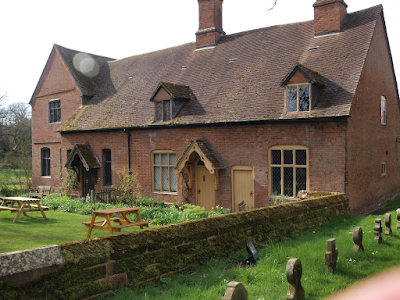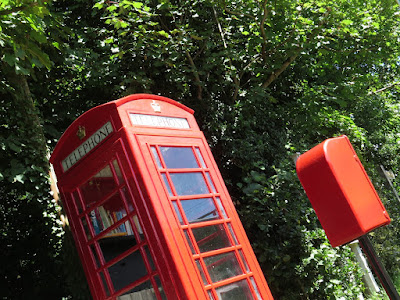BENEATH the trees which screen this ancient site from the road there's only the banks of piled earth to remind us that here once stood a grand manor.
The remains of the Medieval earthworks which give Hobs Moat its name are perhaps striking because they are a survivor from centuries past in a corner of the borough which is overwhelmingly modern.
The remains of the Medieval earthworks which give Hobs Moat its name are perhaps striking because they are a survivor from centuries past in a corner of the borough which is overwhelmingly modern.
Visiting on a bitterly cold January afternoon, the continuous rumble of passing traffic is a reminder that 2024 has you almost entirely surrounded.
And yet in sight of the embankment there is still a sense of separation; you don't have to tread too far from the path to find places where our world of kerbs and concrete feels rather further than 50 yards away.
In other parts of Solihull, Knowle High Street for instance, far more from long ago is still standing whereas these earthworks are about all you might recognise of the local landscape if you were to glance at a map from the 19th or even early 20th century.
The exact origins of the manor which once occupied the site remain the subject of debate, although research suggests that the property was owned by the powerful de Odingsell family - who held sway over the estate at Ulverley as long ago as the 1100s.
Archaeological evidence - the site was most recently excavated in the eighties - suggests the residence may have been abandoned by the end of the 14th century. Perhaps the Black Death, which had arrived on our shores some several decades earlier and cut a swathe through the population, put paid to the settlement.
By the time the celebrated antiquarian William Dugdale visited in 1656 there was already no sign of the stonework, the locals telling him the ruins had long since vanished.
A little over 100 years on a crop of trees was planted on the plot, in time disguising the ditches and mounds which were the last real remnant of what would have once dominated the local countryside.
Perhaps surprisingly what lingers on the north face of a gentle hill is still in impressive condition, according to Historic England, even as whole new housing estates and a busy shopping parade have grown up around it.
In fact it is easy to forget that less than 40 years ago there was genuine concern that the popularity of the mini woodland among the likes of BMX riders was risking rapid erosion.
As Hobs Moat's community website notes "it seemed nothing could be done to save [the location] from increasing deterioration." Indeed it was thanks only to the efforts of a three-year restoration project, which ran in parallel with the archaeological study, that a team was able to safeguard the site's future.
While well preserved, it remains rather hard to appreciate the true scale of what once was here.
Running some 137 metres from north to south and a little less than that in an east-westerly direction, this would undoubtedly have been an imposing fortification in the Middle Ages.
The early 20th century historian Robert Pemberton had concluded that in its heyday the property would have posed a "formidable obstacle" to would-be attackers.
Although a Royal Commission report, published in the late nineties, is more cautious about over-relying on Dugdale's description of the site as "a castle".
"It seems likely that it was in fact a homestead or hunting lodge built perhaps for prestigious reasons and emulating the grander defended house," it said.
Early academics may of course have had to rely on comparisons with still standing properties, like Warwickshire's Baddesley Clinton, to flesh out their impression of what might once have been visible.
Today, by contrast, we have the findings of several archaeological reports, the first investigation taking place in 1955 and then a more thorough survey following 30 years later.
The 1985-88 dig helped shed further light on the manor's past, even if the artefacts uncovered were mainly limited to fragments of 13th century pottery.
Channels were discovered which had apparently allowed water to drain away into the moat. Nearby, meanwhile, there was some evidence of a Medieval hollow way - a form of sunken road - which may once have connected the manor to the original route of Castle Lane.
Perhaps finally it is worth lingering for a moment on the name of the site, which may also offer insight into its busy history.
It is notable that Dugdale makes reference to a local name of "Hoggs Moat" and floated the possibility this was a corruption of the Norman landowners - the Odingsells - who once ruled here. Although more recent study appears to reject this explanation.
Solihull's heritage and local studies team has suggested the name may actually offer clues as to the area's useage after the manor's walls came down. Perhaps, they have speculated, the woodland was a convenient spot for pannage - the practice of releasing hogs (we'd usually say pigs these days) to eat ground-fall nuts such as acorns.
A slightly more intriguing possibility is that the woodland had at one time been associated with an insidious, perhaps even infernal presence. Hob is, of course, an old English name for the Devil. While it's now rather harder to imagine the power supernatural beliefs exerted in centuries gone by it is intriguing that as recently as 1985 The Solihull Times reported on concerns the copse had been used by contemporary followers of witchcraft.
In other parts of Solihull, Knowle High Street for instance, far more from long ago is still standing whereas these earthworks are about all you might recognise of the local landscape if you were to glance at a map from the 19th or even early 20th century.
The exact origins of the manor which once occupied the site remain the subject of debate, although research suggests that the property was owned by the powerful de Odingsell family - who held sway over the estate at Ulverley as long ago as the 1100s.
Archaeological evidence - the site was most recently excavated in the eighties - suggests the residence may have been abandoned by the end of the 14th century. Perhaps the Black Death, which had arrived on our shores some several decades earlier and cut a swathe through the population, put paid to the settlement.
By the time the celebrated antiquarian William Dugdale visited in 1656 there was already no sign of the stonework, the locals telling him the ruins had long since vanished.
A little over 100 years on a crop of trees was planted on the plot, in time disguising the ditches and mounds which were the last real remnant of what would have once dominated the local countryside.
Perhaps surprisingly what lingers on the north face of a gentle hill is still in impressive condition, according to Historic England, even as whole new housing estates and a busy shopping parade have grown up around it.
In fact it is easy to forget that less than 40 years ago there was genuine concern that the popularity of the mini woodland among the likes of BMX riders was risking rapid erosion.
As Hobs Moat's community website notes "it seemed nothing could be done to save [the location] from increasing deterioration." Indeed it was thanks only to the efforts of a three-year restoration project, which ran in parallel with the archaeological study, that a team was able to safeguard the site's future.
While well preserved, it remains rather hard to appreciate the true scale of what once was here.
Running some 137 metres from north to south and a little less than that in an east-westerly direction, this would undoubtedly have been an imposing fortification in the Middle Ages.
The early 20th century historian Robert Pemberton had concluded that in its heyday the property would have posed a "formidable obstacle" to would-be attackers.
Although a Royal Commission report, published in the late nineties, is more cautious about over-relying on Dugdale's description of the site as "a castle".
"It seems likely that it was in fact a homestead or hunting lodge built perhaps for prestigious reasons and emulating the grander defended house," it said.
Early academics may of course have had to rely on comparisons with still standing properties, like Warwickshire's Baddesley Clinton, to flesh out their impression of what might once have been visible.
Today, by contrast, we have the findings of several archaeological reports, the first investigation taking place in 1955 and then a more thorough survey following 30 years later.
The 1985-88 dig helped shed further light on the manor's past, even if the artefacts uncovered were mainly limited to fragments of 13th century pottery.
Channels were discovered which had apparently allowed water to drain away into the moat. Nearby, meanwhile, there was some evidence of a Medieval hollow way - a form of sunken road - which may once have connected the manor to the original route of Castle Lane.
Perhaps finally it is worth lingering for a moment on the name of the site, which may also offer insight into its busy history.
It is notable that Dugdale makes reference to a local name of "Hoggs Moat" and floated the possibility this was a corruption of the Norman landowners - the Odingsells - who once ruled here. Although more recent study appears to reject this explanation.
Solihull's heritage and local studies team has suggested the name may actually offer clues as to the area's useage after the manor's walls came down. Perhaps, they have speculated, the woodland was a convenient spot for pannage - the practice of releasing hogs (we'd usually say pigs these days) to eat ground-fall nuts such as acorns.
A slightly more intriguing possibility is that the woodland had at one time been associated with an insidious, perhaps even infernal presence. Hob is, of course, an old English name for the Devil. While it's now rather harder to imagine the power supernatural beliefs exerted in centuries gone by it is intriguing that as recently as 1985 The Solihull Times reported on concerns the copse had been used by contemporary followers of witchcraft.
Scheduled ancient monuments: Hobs Moat is a rare example locally of a scheduled ancient monument - meaning that its importance is recognised at national level. The monuments are a type of heritage asset which are distinct from the likes of listed buildings and conservation areas. These sorts of sites have in fact been afforded some form of protection as long ago as the late Victorian era. Although the more modern designation dates from 1979. While many of the 20,000 sites logged by Historic England date are hundreds and in some cases thousands of years old, there is - despite the "ancient" labelling - no restriction on more modern structures being added.
References:
An Earthwork Survey at Hobs Moat
Historic England scheduled monument listing
Hobs Moat community website
Solihull and its Church, by Robert Pemberton
Solihull Council heritage and local studies service















